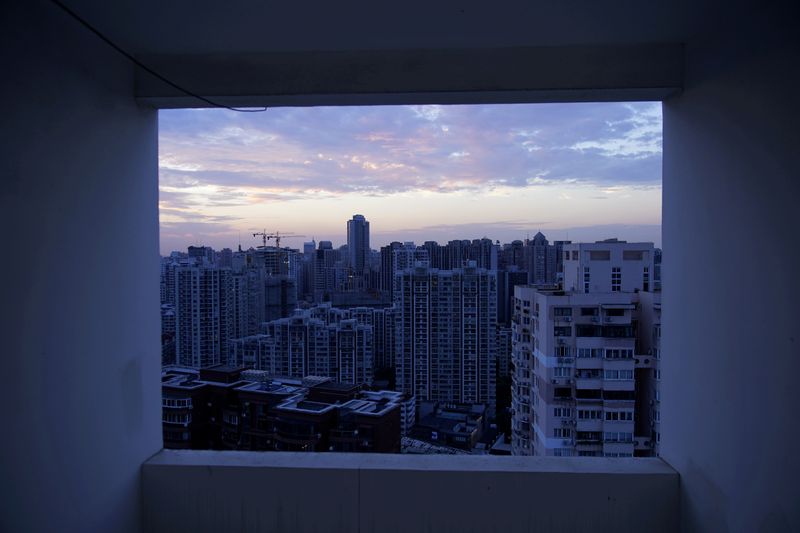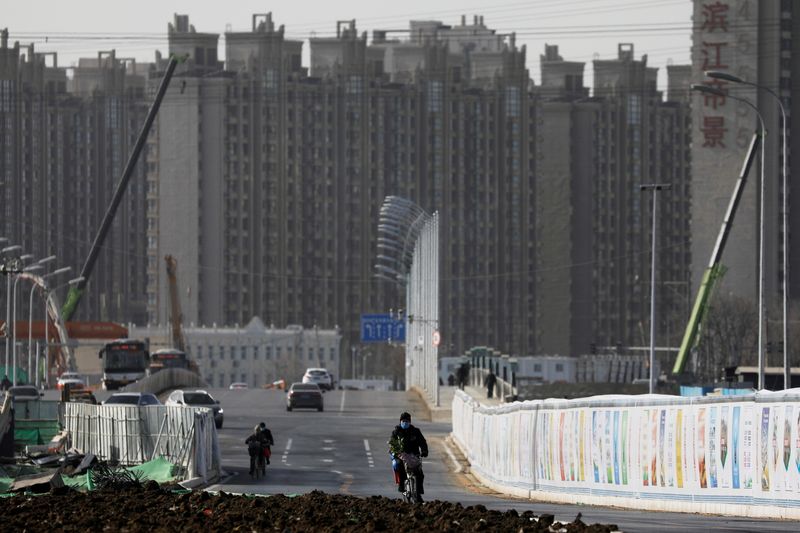BEIJING (Reuters) – China’s property sector, a major driver of economic growth, has weakened sharply this year as Beijing cracks down on speculators and indebted developers in a broad push to ease financial risks, with prices of new homes down for the first time in six years.
In the near term, many analysts expect authorities will try to stabilise the sector, which accounts for a quarter of gross domestic product by some measures, although there is uncertainty over which policy levers Beijing would pull.
Authorities would have to address and navigate challenges on multiple fronts: debt risks, cost-of-living pressures, worried homeowners, and the need to boost economic growth.
DEBT RISKS
Concerns over growing financial risks are a primary driver of the crackdown.
China’s property sector is heavily reliant on credit. As of the end of the second quarter, Chinese developers owed 33.5 trillion yuan ($5 trillion), or a third of the country’s GDP, according to Nomura.
Since authorities last year unveiled the “three red lines” – a significant policy plank aimed at limiting developers’ liabilities-to-assets, net debt-to-equity, and cash-to-short term borrowing ratios – many companies have grown desperately short of cash.
GRAPHIC: Cost of housing in China’s big cities far outstrips incomes https://graphics.reuters.com/CHINA-ECONOMY/xmpjoldbdvr/chart.png
A string of missed offshore debt payments and sell-offs in shares and bonds followed, with China Evergrande Holdings, the world’s most indebted developer, repeatedly lurching to the brink of default.
Bankers and analysts say that Beijing is unlikely to relax the “three red lines” policy any time soon.
COST OF LIVING
Authorities have also slapped lending restrictions on mortgages to deter speculative home buying.
China’s major cities have some of the highest-priced real estate in the world compared to average local earnings.
It would take decades of savings to afford an apartment in Beijing, Shanghai or Shenzhen for someone with a standard salary in those cities.
GRAPHIC: China tier one city house prices https://fingfx.thomsonreuters.com/gfx/ce/jnpwexrybpw/ChinaTier1CitiesPriceOct2021.png
Many who work in these megacities must eventually return to their home towns or move to cheaper inland cities. Cost-of-living pressures have led some young people to embrace a passive lifestyle known as “lying down.”
President Xi Jinping has pledged to reduce inequality and ensure that housing is for living in, not speculation.
GRAPHIC: China’s households put their wealth in real estate https://graphics.reuters.com/CHINA-ECONOMY/akpezmyglvr/chart.png
Prices of new homes dropped 0.2% on average last month from September, according to Reuters calculations, the first decline since 2015.
HOMEOWNER INTERESTS
On the whole, the interests of millions of concerned homeowners are likely to act as an important brake on government policy to excessively cool the sector, say analysts.
Some two-thirds of the wealth of China’s 1.4 billion people is tied up in residential property. Over 90% of urban households own homes, one of the highest rates in the world.
Buying is fuelled by expectations that the government will ensure sustained growth in the sector, as well as by strong social pressures to purchase a house before marriage.
GRAPHIC: China’s real estate sector has global weight https://graphics.reuters.com/CHINA-PROPERTY/znpnekqkgvl/chart.png
Worries that a too-rapid slowdown could spark a market freefall and social unrest will weigh heavily on China’s stability-obsessed government as it tries to balance the risks and rewards of pushing through reforms.
GROWTH WORRIES
Concerns over growth could also limit regulators.
Property and related industries account for about a quarter of China’s GDP, analysts estimate, and drive demand for mountains of steel, cement and other materials.
GDP growth is already slowing sharply this year, with the pace easing off to just 4.9% in the third quarter from a blistering 18.3% in the first.
GRAPHIC: China GDP by sector https://fingfx.thomsonreuters.com/gfx/ce/zgvomklbyvd/ChinaGDPbyProductionType.png
A further significant economic downturn could have ramifications across the world.
If China’s current property slump follows the pattern of the last one in 2014-2015, global GDP growth could be dragged 0.7 percentage points lower in the last quarter of 2022, with metal and iron ore prices plummeting, according to a report by analysts at Oxford Economics.
A more severe deterioration could have China’s GDP growth bottoming out at 1.0% in the first three months of 2023, and global growth taking a substantial hit.
“The worst hit countries would be those for whom exports to China are particularly important and commodity exporters,” said the Oxford analysts.
(Reporting by Gabriel Crossley; Editing by Shri Navaratnam)






















